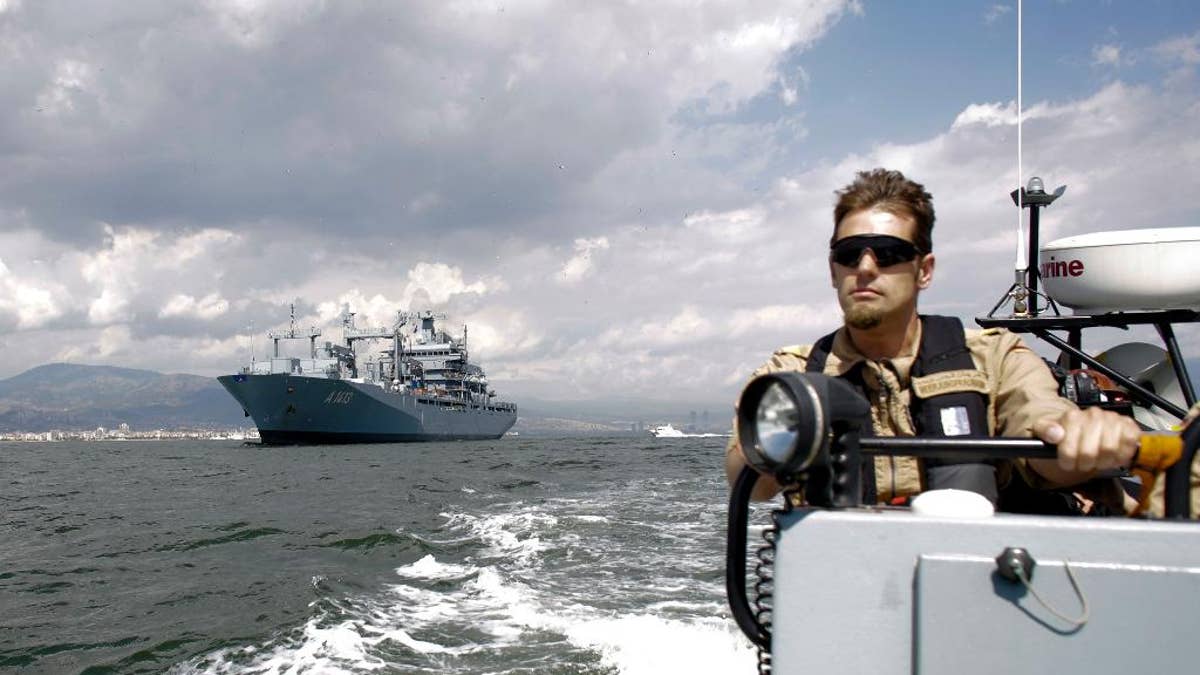
FILE - In this Thursday, May 26, 2016 file photo, The NATO German warship FGS Bonn, left, is escorted by a rescue boat as it departs from the harbor of the city of Izmir, Turkey. The FGS Bonn is part of the NATO flotilla patrolling the Aegean Sea in an effort to curb migrant activity between Turkey and Greece. (AP Photo/Markus Schreiber, File) (The Associated Press)
BRUSSELS – A look at the North Atlantic Treaty Organization (NATO) and European Union, two multinational organizations now cooperating more closely than ever.
COMMON ORIGINS
NATO and the institutions that grew into the EU were born in the ashes of World War II, and the desire to prevent yet another war from devastating Europe.
A 1949 treaty signed in Washington, D.C., created the U.S.-led NATO alliance as a means of countering the military might of the Soviet Union, and preventing the rebirth of the militant nationalisms that had led to Europe's two world wars.
Fostering closer ties between postwar European countries through merging their economies was also seen an effective tool for preventing a revival of nationalist extremism. The initial steps leading to the EU came in 1952 with the pooling of some former enemy countries' coal and steel industries, and the 1957 Rome Treaty that created what was familiarly known as "the Common Market." France and Germany, neighbors that had gone to war three times in the previous 70 years, were core founders.
COMMON MEMBERS
Both NATO and the EU have grown to have 28 members, and 22 European countries belong to both.
In both: Belgium, Britain, Bulgaria, Croatia, Czech Republic, Denmark, Estonia, France, Germany, Greece, Hungary, Italy, Latvia, Lithuania, Luxembourg, Netherlands, Poland, Portugal, Romania, Slovakia, Slovenia, Spain.
In NATO only: Albania, Canada, Iceland, Norway, Turkey, United States.
In the EU only: Austria, Cyprus, Finland, Ireland, Malta, Sweden.
(Montenegro has been invited to become NATO's 29th member, but its membership must be ratified by the U.S. Senate and legislative authorities in other NATO member states).
COMMON HOME BASE
NATO's political and administrative headquarters and most EU institutions, including the executive Commission, are based in Brussels, capital of Belgium.
NATO's headquarters had been in London, then Paris. But when French President Charles de Gaulle decided to withdraw French forces from the alliance's integrated military command structure, NATO moved to Brussels in 1967.
COMMON VALUES AND INTERESTS
NATO and the EU agree they share strategic interests and values, and the alliance is on record as considering the EU "a unique and essential partner." Institutional relations between the organizations officially started in 2001.
NATO's Strategic Concept, adopted in 2010, commits the alliance to preventing crises, managing conflicts and stabilizing post-conflict situations, and calls for working more closely with NATO's partners, especially the EU and United Nations.
With the U.S. and its allies currently facing numerous strategic challenges, including a resurgent Russia and armed Islamic extremism, a joint statement signed with EU officials at July's NATO summit in Poland is expected to take that cooperation to a new level.
